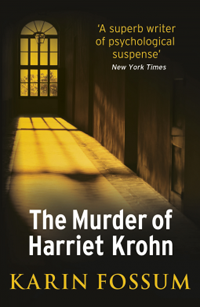Translated by James Anderson — “This Inspector Sejer, the policeman who’s leading the Hamsund murder case, hasn’t had a single unsolved murder in his whole career. And he’s over fifty. How about that?”
The words, uttered by a daughter who is oblivious to his crimes, should make Charlo Olav Torp’s heart sink. However, as he does continually throughout The Murder of Harriet Krohn, Torp puts a light spin on things. He reasons that Sejer’s streak must end at some point, and he believes the police have nothing to connect him to the old lady’s flat. He had observed her from a distance, and somehow found out that she had over 200,000 kroner stashed away in her home. Then one night he went over there with a bouquet of flowers, talked his way in, and demanded her valuables at gunpoint.
But things went wrong. Harriet might have been elderly, wracked by arthritis and vulnerable, but she was no push-over. Indignant at being robbed, she refused to comply and actually tried to fight back. Torp snapped, and in that moment his troubles both began and ended. Yes, he could now pay back his gambling debts. And the silver and jewelery he stole he could put towards buying daughter Julie a horse and rebuilding their relationship. However, he now carries the guilt of Harriet Krohn’s murder.
This guilt is the main focus of Fossum’s seventh Sejer novel, which is an introspection of Charlo’s life from the murder onwards. Whether he’s doing mundane chores, or making new and important promises to Julie, what he’s done lurks in his conscience. He tries to convince himself it wasn’t his fault, chastises himself for losing control, and worries constantly that passing cars are occupied by police detectives. He’s not a bad man, he reasons, and he has the rest of his life to prove it. It’s all very uneasy reading because his thoughts often seem entirely plausible, rational and understandable. A widower estranged from his daughter with huge debts – he was a desperate man.
So far, so psychological, but what about the thriller aspect of it? Sejer, Fossum’s main detective character who stars across the series, first appears on page 186 and only has a distant role in proceedings until the final few chapters. Like When the Devil Holds the Candle, this book is from the perspective of the perpetrator and is not a mystery at all. There’s an air of inevitability to the proceedings. We are privy to every little worry Torp experiences – about being caught, about letting Julie down again, about his health – and there is a certain amount tension in this, but there are few surprises.
In fact, there seems to be a dull normality to Torp’s post-murder life. This seems very much to be one of the points Karin Fossum is making. However, there’s not quite enough here to feel truly gripped by the book. Fossum’s non-Sejer novel I Can See In The Dark is also from the criminal’s perspective, but in that novel the psychotic Riktor is full of strange habits, peculiarities and odd ideas. He’s fascinating in his nastiness, and there’s a wry irony in that book which is missing in the story of Charlo Olav Torp.
Consequently, you’ll wish Inspector Sejer would arrive to sort things out sooner than he does, rather than read ten more ways Torp has found to deceive himself. When will he ever face up to the brutal violence he’s enacted? Thankfully, when Sejer does arrive in the story, it takes on a new texture. He dominates it like a force of nature, moving with the speed and yet the power of a glacier, it seems. Sejer is like a wall of ice in between Torp and his future happiness.
This is a thoughtful dissection of crime and its consequences which is well written and has its interesting moments. However, as unnerving as it is in places, it lacks the twists and tension of Fossum’s other novels. That could be why it’s the last Sejer novel to see translation.
Read our guide to the Inspector Sejer series here.
Harvill Secker
Print/Kindle/iBook
£6.02
CFL Rating: 3 Stars









